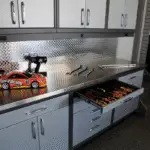Imagine waking up, grabbing your water bottle, and stepping right into your own private gym—no traffic, no waiting, no excuses. That’s the magic of a garage gym.
Post-pandemic, more people are turning their garages into personalized fitness spaces, and for good reason. Not only does a garage gym save time and money in the long run, but it also gives you the freedom to work out on your own terms. Whether you’re a busy parent, a fitness enthusiast, or just someone tired of monthly gym fees, converting your garage into a gym could be the lifestyle upgrade you didn’t know you needed.
In this guide, we’ll cover everything—from deciding if a garage gym is right for you, to 12 real-world layout ideas, step-by-step planning, essential gear, safety tips, and motivation hacks. By the end, you’ll know exactly how to transform your garage into a space that inspires you to move, lift, and grow stronger—right at home.

🚗🏋️ Part 1: Understanding the Basics Before You Start
Is a Garage Gym Right for You?
Before you grab that sledgehammer and start clearing out your garage, take a moment to reflect:
- Are you tired of commuting to the gym?
- Do you want to work out more consistently?
- Do you value privacy, flexibility, and long-term savings?
If the answer to most of those is “yes,” then yes—a garage gym could be a fantastic investment.
You don’t need a massive space or fancy equipment to start. What you do need is a little planning and a clear understanding of your goals. Do you want a minimalist setup for bodyweight workouts? Or a powerlifting station? Maybe a family-friendly mix? The layout will depend on your unique needs.
Pros and Cons of Garage Gyms
✅ Pros:
- Convenience: Open 24/7, just steps away from your kitchen.
- Cost-effective: Save thousands annually on gym memberships.
- Customizable: Create a vibe that motivates you.
- No waiting: Your squat rack, your rules.
❌ Cons:
- Temperature swings: Garages aren’t insulated like your living room.
- Noise: Dropping weights could annoy neighbors or sleeping kids.
- Space limitations: Sharing space with storage—or your car—can be tricky.
Still in? Let’s dive deeper.
Essential Questions to Ask Before You Begin
Before you start assembling squat racks, ask yourself:
- Do I need to keep parking my car here?
If yes, you’ll need a layout that’s compact and/or foldable. - What kind of workouts will I do?
Strength, cardio, HIIT, yoga—all require different floor plans. - Will this be for one person or multiple users?
Sharing with a spouse or family member? You’ll need designated zones. - How much do I want to spend upfront?
You can start under $1,000—or go all-in with a $10k setup.
🛠️ Part 2: Planning Your Garage Gym Layout
Measuring and Mapping Out Your Space
Start with the basics: Grab a tape measure and jot down your garage’s length, width, and ceiling height. Most garages are either:
- Single-car: ~12×20 ft
- Double-car: ~20×20 ft or larger
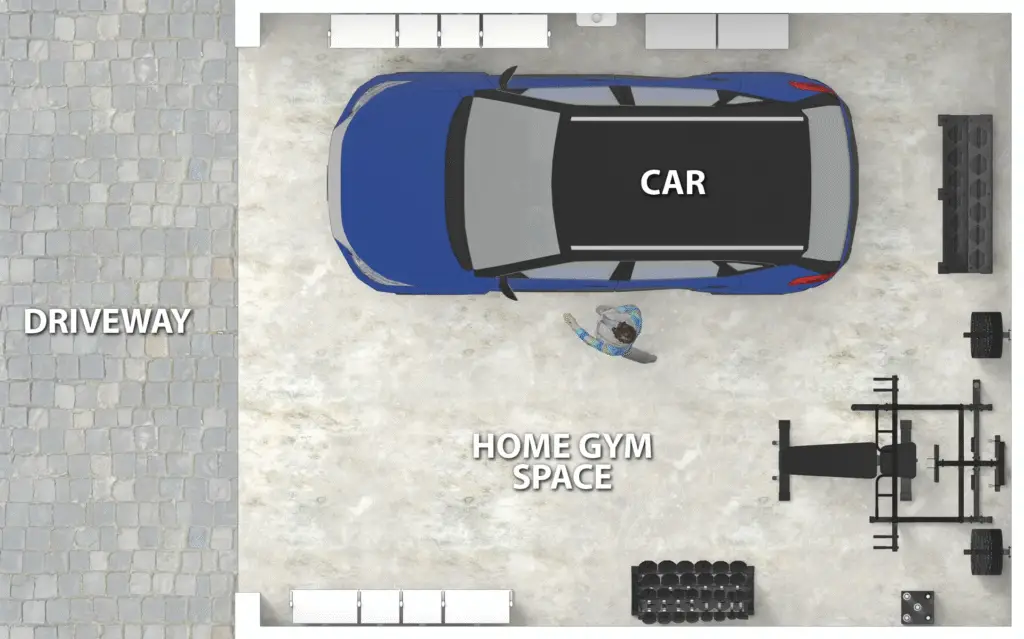
Use free tools like SketchUp or GridPaper to map it digitally, or use graph paper and a ruler. Plan for zones, even in a tight space:
- Strength zone: For racks, weights, and benches
- Cardio zone: Treadmill, rowing machine, bike
- Stretch/recovery zone: Mats, foam rollers, yoga blocks
Addressing Flooring First
Don’t make the rookie mistake of skipping the floor—it matters more than you think.
Why it’s crucial:
- Protects your concrete
- Reduces joint impact
- Prevents slipping
- Dampens sound
Best options:
- 🟩 Rubber Stall Mats: Durable and great for heavy lifting
- 🟨 Foam Tiles: Comfortable, but less ideal for weight drops
- 🟦 Interlocking Rubber Tiles: Easier to install, clean look
Installation Tips:
- Leave space at the edges to prevent buckling
- Clean and dry the floor thoroughly before installation
- Use double-sided tape or adhesive if needed

Temperature and Climate Control
Let’s face it—garages weren’t built for comfort. Here’s how to make them workout-ready year-round.
Hot summers?
- Portable AC units or fans
- Reflective window film to block sunlight
- Insulate the garage door
Cold winters?
- Space heaters (ceramic or oil-filled)
- Insulated panels on the walls
- Thermal gym flooring
Ventilation matters too.
If you’re doing high-intensity workouts, install an exhaust fan or at least crack open a window and run a fan for airflow.
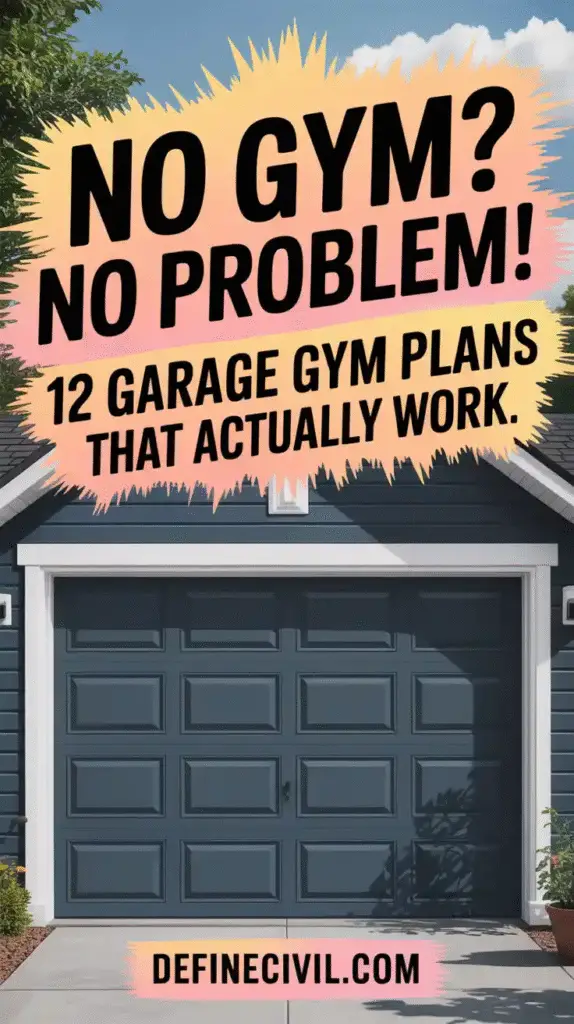
Lighting and Ambience
Dim, flickering lights don’t inspire burpees. You need bright, energizing, and safe lighting.
Lighting tips:
- Use LED shop lights for budget-friendly brightness
- Add strip lighting around mirrors or ceilings for ambiance
- If you have windows, take advantage of natural light
- Consider smart bulbs to switch between cool white and warm yellow tones
Mirrors:
They’re not just for vanity. Full-length mirrors help you check your form, reflect light, and make the space feel bigger.
12 Garage Gym Layout Ideas That Actually Work
There’s no one-size-fits-all approach to garage gyms. Your layout should reflect how you train, how much space you have, and how much you’re willing to invest. Below are 12 real-world garage gym layouts, tailored to different lifestyles, fitness goals, and budgets.
1. The Minimalist Garage Gym
Ideal for: Bodyweight trainers, beginners, or small-space users
Sometimes less is more. A minimalist gym focuses on essential movements with minimal equipment.
Core features:
- Wall-mounted pull-up bar
- Foldable workout bench
- Adjustable dumbbells
- Resistance bands
- Foam mat for floor work
Why it works:
Small footprint. Easy to maintain. You can even park your car next to it.
Pro Tip: Mount a collapsible wall desk nearby for tracking your workouts or following video sessions.
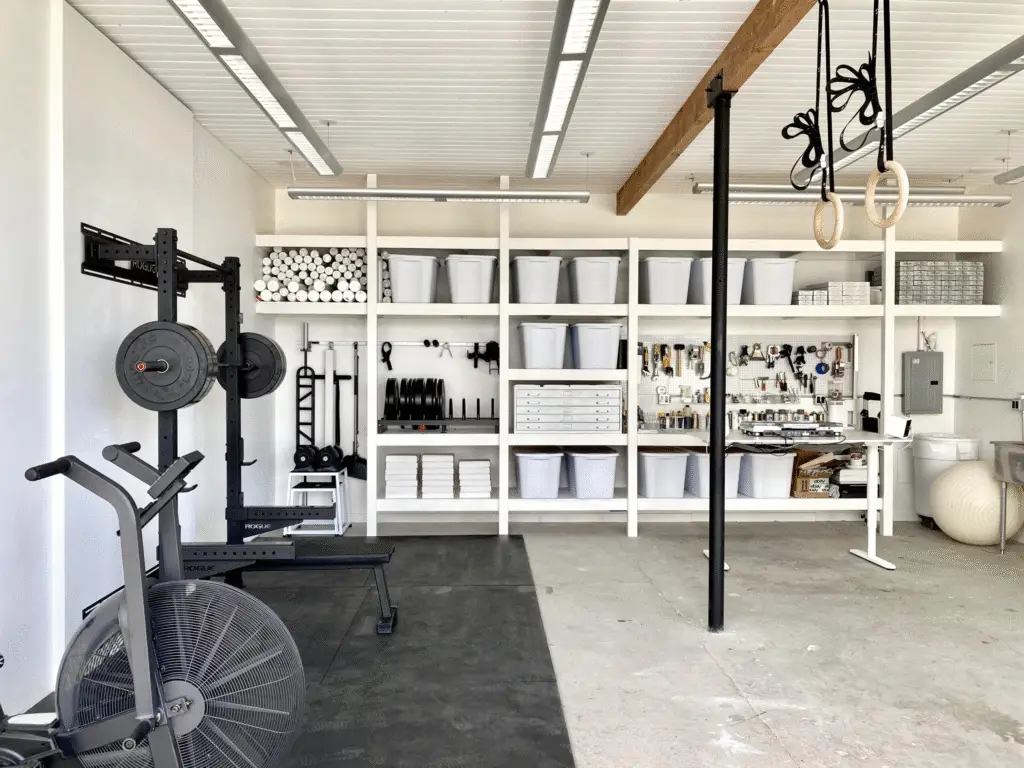
2. Powerlifting Paradise
Ideal for: Lifters focused on compound strength movements
Got a solid concrete slab? You’re ready to build your iron temple.
Core features:
- Power rack or half-rack
- Barbell and bumper plates
- Deadlift platform
- Adjustable bench
- Plate storage tree

Layout tip: Center the rack with enough clearance on all sides for safe spotting and movement.
Must-have: Chalk bucket + a fan (trust me).
3. CrossFit-Inspired Garage Gym
Ideal for: CrossFit athletes or HIIT enthusiasts
This layout blends lifting with dynamic bodyweight and cardio moves.
Core features:
- Rig with pull-up and squat attachments
- Kettlebells, wall balls, plyo boxes
- Rower or air bike
- Open space for WODs
Wall space: Use it for mounted timer, storage hooks, and wall ball target.
Pro Tip: Install rubber flooring throughout to absorb impact.

4. Small Single-Car Garage Gym
Ideal for: Tight spaces and creative thinkers
Don’t let size stop you. With smart planning, you can turn a single bay into a beast zone.
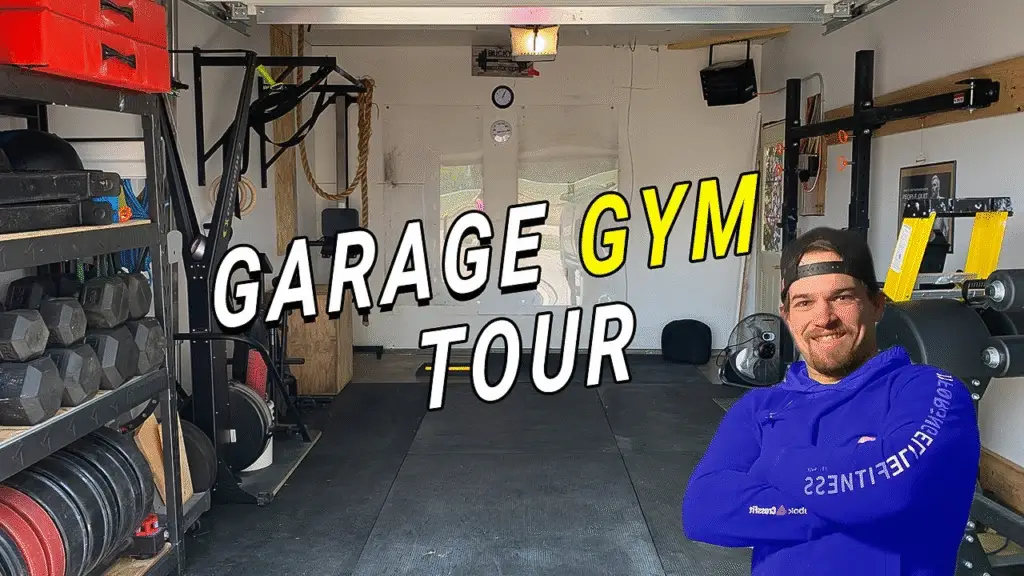
Core features:
- Foldable squat rack
- Wall-mounted pulley or resistance system
- Compact adjustable bench
- Vertical storage racks
Storage tip: Install overhead shelving and use pegboards for gear organization.
(Related: [Declutter Your Garage with These 20 Inventive Garage Mudroom Ideas])
5. Cardio-Focused Garage Gym
Ideal for: Runners, cyclists, endurance athletes

Prioritize machines and heart-rate boosting equipment.
Core features:
- Treadmill or rowing machine
- Spin bike or elliptical
- TV or tablet wall mount for virtual workouts
- Small dumbbell rack + yoga mat
Sound tip: Use rubber mats under each machine to reduce vibrations.
6. HIIT and Functional Training Space
Ideal for: Explosive training, agility work, metabolic circuits
If your workouts look like obstacle courses—this is for you.
Core features:
- Turf strip for sled pushes
- Kettlebells and medicine balls
- Battle ropes anchored to the wall
- Suspension trainer (e.g., TRX)
- Jump ropes, agility ladders
Layout tip: Leave as much open floor space as possible.

7. The Yoga + Strength Combo Studio
Ideal for: Those who love mind-body fusion workouts
Create a peaceful zone with enough flexibility for dynamic movement.
Core features:
- Soft flooring (rubber + yoga mat)
- Dumbbells and light kettlebells
- Full-length mirror and diffuser
- Bluetooth speaker or soundbar
- Foldable bench
Design tip: Use calming wall colors like light blue, sage green, or off-white.
8. Family-Friendly Garage Gym
Ideal for: Parents who want to work out while the kids play
Design with safety, flexibility, and fun in mind.
Core features:
- Separate kid-safe area with mats or mini-trampoline
- Lighter weights + adjustable gear for spouse/partner
- Secure wall storage for heavy equipment
- Foam flooring throughout
Bonus: Add a chalkboard wall for workout tracking and a place for kids to draw.
9. Luxury Home Gym in the Garage
Ideal for: High-end homeowners or fitness connoisseurs

This isn’t just a garage—it’s a wellness sanctuary.
Core features:
- Premium rubber or epoxy flooring
- Mirror wall + built-in lighting
- Smart gym system (Tonal, Tempo, or Mirror)
- Audio surround system
- Climate control unit
Style tip: Use warm woods, leather handles, and matte black fixtures to elevate the look.
10. Budget-Friendly Garage Gym Setup
Ideal for: DIYers or those starting with limited funds
You can still lift heavy without draining your wallet.
Core features:
- Secondhand squat rack or DIY rack
- Craigslist dumbbells
- Homemade plyo box
- Resistance bands
- Yoga mat + jump rope
Money tip: Check Facebook Marketplace or OfferUp for used equipment.
11. Garage Gym for Seniors or Rehab
Ideal for: Older adults or those recovering from injuries
Focus on stability, low-impact cardio, and safety.
Core features:
- Recumbent bike or step machine
- Parallel bars or balance tools
- Light dumbbells + resistance bands
- Anti-slip rubber flooring
Add-ons: Grab bars and non-skid mats near machines for added safety.
12. Hybrid Garage Gym + Storage
Ideal for: Multi-purpose garages
This layout keeps your car or tools while still offering a decent workout area.
Core features:
- Fold-away or wall-mounted rack
- Stackable equipment bins
- Rolling dumbbell cart
- Wall shelves + bike hooks
Organization tip: Keep gym gear on one wall, storage/tools on another.
(Related: [15 Must-Have Features for Your Dream Garage])
✅ Summary Table: Which Layout Suits You?
| Layout | Best For | Key Feature |
|---|---|---|
| Minimalist | Beginners | Compact & easy |
| Powerlifting | Heavy lifters | Rack + platform |
| CrossFit | Functional athletes | Open zone |
| Small Garage | Tight spaces | Foldable gear |
| Cardio | Endurance | Machines |
| HIIT | Explosive training | Turf + ropes |
| Yoga + Strength | Mind-body | Calm & flexible |
| Family-Friendly | Parents | Safety zones |
| Luxury | High-end | Premium aesthetics |
| Budget | DIYers | Used gear |
| Senior/Rehab | Stability | Low-impact tools |
| Hybrid | Storage + fitness | Foldable equipment |
Equipment Guide for Every Type of Garage Gym
Must-Have Equipment for Any Garage Gym
No matter your workout style, some pieces are essential because they’re versatile, space-efficient, and effective:
- Adjustable Dumbbells: Replace dozens of fixed weights with a single pair that can change weight.
- Adjustable Bench: From bench presses to step-ups and seated exercises, it’s a must-have.
- Power Rack or Squat Stand: Essential for barbell lifts and safety with spotter arms.
- Barbell & Plates: Olympic barbells with bumper plates are ideal for strength training.
- Pull-Up Bar: Wall-mounted or part of a rig, it adds bodyweight training variety.
These basics set the foundation. Even with minimal gear, you can get an effective full-body workout.
Cardio Gear Options
Cardio is key for heart health, endurance, and burning calories. Depending on your space and budget, consider:
- Treadmill: A classic, great for walking/running year-round.
- Rowing Machine: Full-body cardio with low impact, perfect for tight spaces.
- Spin Bike or Air Bike: Great for HIIT workouts and cycling enthusiasts.
- Jump Rope: Ultra-budget-friendly and portable cardio tool.
Pro Tip: Place cardio machines near an outlet and a TV or tablet stand for entertainment.
Storage and Organization
An organized gym is a motivating gym.
- Wall-Mounted Racks: Use vertical space to hang kettlebells, bands, ropes, and even dumbbells.
- Overhead Storage: Ceiling racks can store seasonal items or less-used gear, freeing floor space.
- Pegboards: Great for quick access to smaller equipment.
- Rolling Carts: Store smaller accessories and move them out of the way when needed.
DIY storage hacks: Use PVC pipe holders for barbells or repurpose shoe organizers for small gear.
How to Set Up Your Garage Gym (Step-by-Step)
Step 1: Clear and Clean the Space
Start fresh. Remove everything not related to your gym. Old boxes, tools, paint cans—get them out or relocate.
Cleaning tips:
- Sweep thoroughly to remove dust and debris.
- Use degreaser on oil spots for safety.
- Wash floors with a mild detergent if needed.
A clean space feels welcoming and safe.
Step 2: Install Flooring
Follow these steps for an effective gym floor:
- Prepare the floor: Ensure it’s dry and smooth.
- Lay down mats or tiles: Start from one corner, interlocking tiles if needed.
- Use tape or adhesive: To prevent shifting.
- Test stability: Walk, jump, and drop a light weight to check for movement.
Good flooring protects both you and your concrete.
Step 3: Add Lighting and Mirrors
Position your lights to eliminate shadows, ideally overhead or on walls.
Mirror tips:
- Install securely to avoid accidents.
- Place near your main workout zone for easy form checks.
If natural light is limited, consider full-spectrum bulbs to mimic daylight and boost energy.
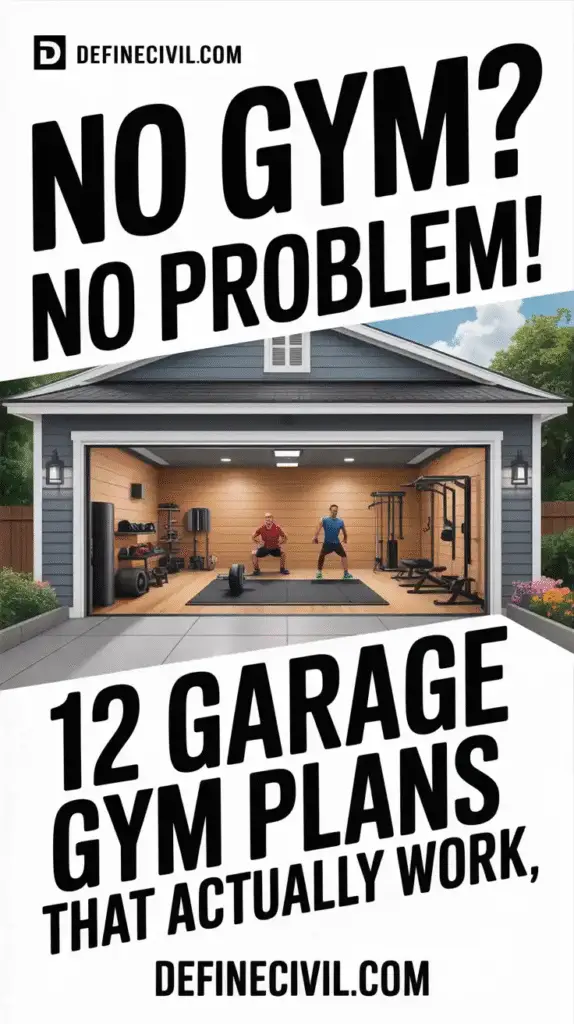
Step 4: Move in Equipment Strategically
Start with big items first:
- Rack or bench placement with enough clearance
- Cardio machines near power outlets
- Storage solutions along walls
Leave enough space to move safely between equipment and avoid clutter.
Step 5: Add Personal Touches
Make it yours:
- Hang motivational posters or quotes
- Install a Bluetooth speaker for your playlists
- Use chalkboards or whiteboards for tracking progress
- Add plants or scents to boost mood
A personal gym is a happy gym.
Psychology and Motivation in Garage Gyms
Why Your Environment Affects Your Workout
Have you ever noticed how a cluttered, dull space kills your workout vibe? Your environment profoundly impacts your motivation and performance. A clean, well-lit, and inspiring garage gym primes your brain to switch into “workout mode.”
Think of your gym like a stage — the right setting helps you perform your best. Bright lighting, motivational quotes, and music can create positive energy, making workouts something you look forward to rather than dread.
Motivation Hacks for Garage Gyms
- Create a workout playlist: Music is proven to boost endurance and mood. Curate upbeat, high-energy songs to power through tough sets.
- Visual boards: Post your goals, progress photos, or a calendar with workout schedules.
- Set micro-goals: Celebrate small wins like adding 5 lbs to your lift or doing one more rep.
- Invite accountability: Workout with a partner virtually or in person, or join online fitness challenges.
- Keep it fresh: Rotate equipment or try new workout routines to avoid boredom.
Maintenance, Safety, and Upgrades
Regular Maintenance Tips
Keeping your garage gym in top shape makes it safer and more inviting.
- Weekly: Sweep floors, wipe down equipment, and check for wear and tear on cables or mats.
- Monthly: Deep clean mirrors, lubricate moving parts on machines, and inspect for rust.
- Seasonally: Check ventilation, heaters, or air conditioners for functionality.
Safety Considerations
- Flooring load limits: Concrete floors generally handle gym equipment well, but avoid stacking too much weight in one spot.
- Fire hazards: Keep flammable items away and consider a small fire extinguisher.
- Equipment stability: Anchor racks and machines securely to prevent tipping.
- Proper lighting: Prevent accidents by ensuring the workout area is well-lit.
When and How to Upgrade
Start simple, but don’t hesitate to upgrade as you grow.
- Invest in better flooring or lighting when budget allows.
- Add more specialized equipment as your fitness needs evolve.
- Consider smart gym tech for tracking and guidance.
- Upgrade storage solutions to keep the space tidy.
FAQs – What People Ask About Garage Gyms
Can I park my car and still have a gym?
Yes! Use fold-away racks, vertical storage, and compact equipment to share space efficiently.
Do I need a permit to install a garage gym?
Usually not, unless you’re doing major renovations or electrical work. Check local regulations to be sure.
How do I soundproof my garage gym?
Use rubber flooring, add insulation to walls and ceiling, seal gaps, and consider acoustic panels.
What’s the cost of building a basic garage gym?
Basic setups start around $500-$1,000; full-featured gyms can go above $10,000 depending on equipment and finishes.
Can I finance my garage gym setup?
Many equipment stores and online retailers offer financing plans. You can also consider personal loans or credit options.
📝 Conclusion: You’ve Got the Garage, Now Build the Gym
Transforming your garage into a home gym is more than just a renovation—it’s an investment in your health, happiness, and lifestyle freedom. Whether you choose a minimalist setup or a full luxury gym, the key is to start where you are, plan smartly, and stay motivated.
Remember: every great journey starts with one step (or one rep). So clear that garage, roll out those mats, and get moving!
Ready to build your dream garage gym? Share your plans, questions, or favorite layouts in the comments below. And don’t forget to pin this guide for your future reference!




